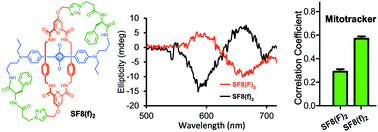Chiral figure-eight molecular scaffold for fluorescent probe development†
Abstract
Targeted fluorescent molecular probes are useful for cell microscopy, diagnostics, and biological imaging. An emerging discovery paradigm is to screen libraries of fluorescent molecules and identify hit compounds with interesting targeting properties. However, a current limitation with this approach is the lack of fluorescent molecular scaffolds that can produce libraries of probe candidates with three dimensional globular shape, chiral centers, and constrained conformation. This study evaluated a new probe scaffold called squaraine figure-eight (SF8), a self-threaded molecular architecture that is comprised of an encapsulated deep-red fluorescent squaraine dye, surrounding tetralactam macrocycle, and peripheral loops. Easy synthetic variation of the loops produced four chiral isomeric SF8 probes, with the same log P values. Cell microscopy showed that subtle changes in the loop structure led to significant differences in intracellular targeting. Most notably, a comparison of enantiomeric probes revealed a large difference in mitochondrial accumulation, very likely due to differences in affinity for a chiral biomarker within the organelle. A tangible outcome of the research is a probe candidate that can be: (a) developed further as a bright and photostable, deep-red fluorescent probe for mitochondrial imaging, and (b) used as a molecular tool to identify the mitochondrial biomarker for selective targeting. It will be straightforward to expand the SF8 probe chemical space and produce structurally diverse probe libraries with high potential for selective targeting of a wide range of biomarkers.

- This article is part of the themed collection: Supramolecular chemistry in OBC


 Please wait while we load your content...
Please wait while we load your content...